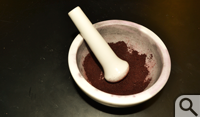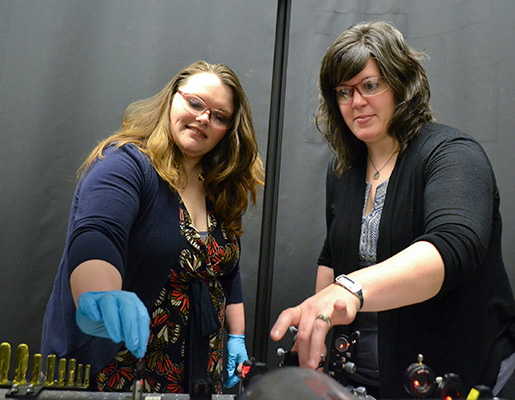Ready for Rembrandt?
Graduate student will examine pigments using SERS laser
Shelle Butler is going to Amsterdam this summer to work with some of the world’s most highly valued works of art.
“But I won’t be actually touching the Rembrandts,” she said, affecting a little wide-eyed shudder of horror. “I’ll be back over there in the corner with my lasers.”
The apprehension may be fake, but the Rembrandts are very real. Butler will be part of a team working to identify pigments used by Rembrandt van Rijn in the 17th century. And, yes, there will be lasers.
Butler is pursuing a master’s degree in William & Mary’s Department of Chemistry. She is one of four U.S. graduate students chosen to participate in one of National Science Foundation’s programs known as IRES — International Research Experiences for U.S.-based Students (IRES).
Her program, Cultural Heritage Research in the Netherlands, is administered through Northwestern University. The work will be primarily in the Atelier Building (Ateliergebouw), the conservation workshop of the Rijksmuseum, the national museum of the Netherlands.
Butler can’t speak about which Rembrandt paintings she will work with. There are plenty of possibilities: Wikipedia puts the Rijksmuseum’s Rembrandt census at 25, including many cream-of-the-crop works such as “The Night Watch” and the wedding portraits of Marten Soolmans and Oopjen Coppit, described in a Rijksmuseum video as “the Kim Kardashian and Kanye West of the Golden Age.”
Even though Butler is a first-year master’s student, she is already an experienced color chemist, having acquired enough lab chops to be selected for the competitive IRES program over candidates pursuing Ph.D. degrees.
Butler has worked within a long-standing and fruitful collaboration between Shelley Svoboda, a senior conservator of paintings at the Colonial Williamsburg Foundation, and Kristin Wustholz, associate professor of chemistry at William & Mary. Svoboda and Wustholz have mastered a technique for chemical analysis of paints and pigments used in historic and vintage paintings.
Butler has considerable experience with the Svoboda-Wustholz Technique, beginning with an understanding of the division of labor.
“It all starts with Shelley, the conservator,” Butler explained. “The conservator collects samples from the painting. Then I go over to Shelley’s lab.”
Svoboda transfers the paint samples to a microscope slide and then Butler takes over, spotting the miniscule samples with even small silver nanoparticles.
“Then I take the treated samples back to our lab in the ISC,” she continued. The samples go through a technique known as SERS — surface enhanced Raman spectroscopy
“I use a laser to excite the sample and so the pigment and the silver nanoparticles will have an interaction. Essentially, the silver nanoparticles ‘amplify’ the chemical fingerprint of whatever pigment we have.”
It works because the laser causes each pigment to produce its own Raman spectrum, the phenomenon that Butler called a “fingerprint.” Just as a police officer looks through a library of actual fingerprints for a match to a print lifted from the scene of a crime, Butler checks a library of chemical color fingerprints for a match to her SERS result. Wustholz refers to the technique as “minimally destructive,” which in layman’s terms means that a conservator needs to remove only the teeniest chip of paint for analysis.
Butler’s pigment experience came from working on a number of paintings, some of them with the staff of William & Mary’s own Muscarelle Museum of Art, others, such as works by William Dering and Charles Willson Peale, in the big leagues of historic paintings.
But there are the big leagues — and then there is Rembrandt.
“I think Shelle’s ready. I hope she is,” Wustholz said. “But is anybody ever really ready for Rembrandt?”
She added that if anybody is ever ready for Rembrandt, it’s Shelle Butler. In the first place, Wustholz expects the laser-enhanced spectroscopy conducted in the Ateliergebouw to be very familiar work for her student. Butler’s Svoboda-Wustholz experience is excellent preparation for the work ahead in Amsterdam.
“Not many labs in the world are using SERS for art and historical artifacts,” Wustholz said. “Maybe a dozen or so.”
She said Butler will bring both theoretical and practical experience to the laboratories of Amsterdam. Wustholz noted that Butler has worked through some challenges, addressing some knotty issues with the synthesis of the silver nanoparticles necessary for the technique. Plus, Butler heads to Amsterdam with substantial experience in analysis of period colors, especially reds.
 “So far, let’s see: I’ve worked with lots of carmine red, which is really cool, because that originates from cochineal insects,” she said. “You get them dried and you mortar-and-pestle them. Madder red is plant-based. I’ve also looked at Prussian blue — that’s an inorganic synthesized dye that dates to the early 18th century. It’s really neat finding the origins of these artist pigments. Essentially, they’re animal, vegetable or mineral.”
“So far, let’s see: I’ve worked with lots of carmine red, which is really cool, because that originates from cochineal insects,” she said. “You get them dried and you mortar-and-pestle them. Madder red is plant-based. I’ve also looked at Prussian blue — that’s an inorganic synthesized dye that dates to the early 18th century. It’s really neat finding the origins of these artist pigments. Essentially, they’re animal, vegetable or mineral.”
One of the most common concerns for conservators of historic paintings is the source of the red pigments used. Svoboda explained that even in works that don't seem to show much red, the color is a necessary, component of skin tones.
“Though the color can be very subtle, particularly in the case of organic reds, they are particularly sought after in the flesh areas throughout the history of painting,” she explained. “Certain artists really found that these organic dye-based colors give a living quality that not other non-fading pigments.”
The plant- and insect-based reds fade in the light, becoming what is known as a “fugitive” color. SERS excels at chasing down the identity of a fugitive pigment. Svoboda points out that a museum armed with knowledge of a work’s pigments is prepared to address a number of issues. One such issue might be how best to go about repairing damaged areas through a process known as “inpainting.”
Museums, of course, want to stop or slow fading, keeping fugitive colors from fleeing even farther. SERS can answer important questions about optimum conditions for fade-resistant displaying of Peales, Rembrandts and other masterpieces. Svoboda said SERS analysis can revise long-standing best practices in museums.
“It’s been assumed that many oil-based paintings have no organic dye-based color content,” she explained. “So, it was naturally assumed that they are able to take higher light levels than, perhaps paper objects or textiles.”
Butler’s work in the Ateliergebouw will help to provide answers as the Rijksmuseum considers best courses of action for their collection of Rembrandts. She’ll leave June 2 for a two-month stay. She is an Air Force veteran and has lived in Europe before, but this will be her first trip to Amsterdam. She goes with some basic guidance from her mentor.
“My advice to her is to just apply what you’ve learned on a more modest scale,” Wustholz said. “Breathe. Be calm. Observe everything. Write down everything.”















